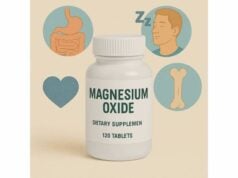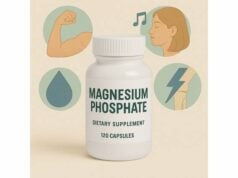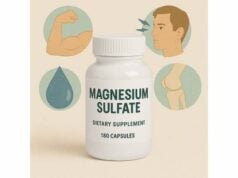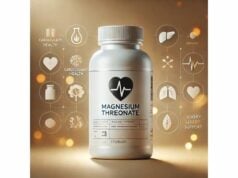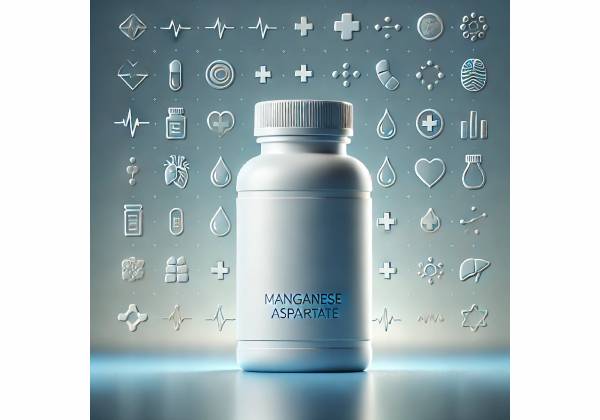
Manganese aspartate is a supplemental form of the essential trace mineral manganese bound to the amino acid L-aspartic acid. Your body needs small, steady amounts of manganese to run antioxidant enzymes, build connective tissue and bone, support blood clotting alongside vitamin K, and help convert carbohydrates and fats into usable energy. Because manganese deficiency is rare on balanced diets, most people meet their needs through food. Even so, manganese aspartate appears in some multivitamins and targeted formulas to provide a reliable micro-dose of elemental manganese in a compact capsule or tablet.
This guide explains what manganese aspartate is, where it fits among manganese forms, how it behaves in the body, and when supplementation makes sense. You will find practical guidance on dosing, timing, and interactions—especially with common antibiotics and other minerals—plus clear safety guardrails such as tolerable upper limits. Where evidence is limited or preliminary, that’s stated plainly so you can make informed, conservative choices.
Key Insights
- Supports antioxidant enzymes and connective tissue; best used to meet, not exceed, daily needs.
- Typical supplemental dose: 1–4 mg elemental manganese/day; do not exceed 11 mg/day without medical advice.
- Separate from tetracyclines and fluoroquinolones by several hours to avoid chelation and reduced antibiotic effect.
- Avoid supplementation in chronic liver disease, manganese toxicity risk, or when total intake already approaches the upper limit.
Table of Contents
- What is manganese aspartate?
- What benefits does it offer?
- How to use it correctly
- What affects absorption and results?
- Mistakes to avoid and quick fixes
- Side effects, interactions, and who should avoid
- Evidence snapshot and dosage summary
What is manganese aspartate?
Manganese aspartate is an “amino acid chelate”—a supplement in which elemental manganese (Mn) is paired with L-aspartic acid. The chelate helps stabilize the mineral and may improve tolerability compared with harsher salts (for example, manganese sulfate). Importantly, the amount printed on a Supplement Facts label refers to elemental manganese, not the total weight of manganese aspartate. A capsule listing “2 mg manganese (as manganese aspartate)” provides 2 mg of manganese and a small amount of aspartate as the carrier.
Inside the body, manganese serves as a cofactor for several enzymes:
- Manganese superoxide dismutase (MnSOD) in mitochondria, a front-line antioxidant enzyme.
- Arginase, tied to urea cycle function and nitric oxide balance.
- Pyruvate carboxylase and other enzymes involved in glucose and lipid metabolism.
- Enzymes that support cartilage and bone matrix formation and blood clotting alongside vitamin K.
Dietary sources (whole grains, nuts, legumes, tea, some spices) typically cover needs. The body also tightly regulates manganese: most absorbed Mn is excreted via bile. This means deficiency is uncommon in healthy adults, and supplementing is usually about meeting an intake target rather than “treating” a shortage.
Where does manganese aspartate fit among forms? Supplement shelves include manganese gluconate, sulfate, citrate, bisglycinate/glycinate, picolinate, and aspartate. At typical micro-doses (1–4 mg/day), no clinically decisive difference in bioavailability among oral forms has been established. In other words, pick a form based on dose accuracy, tolerability, third-party testing, and how it pairs with the rest of your stack—not because one form is universally “stronger.”
What about the aspartate part? Aspartic acid is a common amino acid found in food and proteins. In manganese aspartate, it functions primarily as a ligand; the quantity you ingest from a standard micro-dose is small and nutritionally routine.
When might a manganese aspartate supplement be considered?
- You use a minimalist multivitamin that omits manganese and your diet skews low in whole grains, nuts, and legumes.
- You’re building a bone and connective-tissue support stack (e.g., adequate protein, vitamin D, vitamin K, magnesium) and want to ensure manganese intake reaches the adult Adequate Intake (about 2.3 mg/day for men and 1.8–2.0 mg/day for women).
- You need a known, precise micro-dose (1–2 mg) that is easy to separate from interacting medications.
If your existing multivitamin already supplies 2–4 mg of manganese, adding a standalone manganese aspartate is usually unnecessary and may push total intake toward the upper limit without benefit.
What benefits does it offer?
Because manganese is an essential cofactor, the clearest “benefit” is adequacy: keeping daily intake within the physiologic sweet spot so antioxidant defenses and tissue enzymes work normally. Key areas where adequate manganese matters include:
1) Mitochondrial antioxidant support
MnSOD converts superoxide radicals into less reactive species inside mitochondria. This function is fundamental rather than flashy: you won’t “feel” it the way you might notice caffeine, but it’s part of the biochemical scaffolding that protects cells from routine oxidative stress. Ensuring intake meets daily needs supports this system.
2) Bone and connective tissue
Enzymes dependent on manganese participate in the formation of proteoglycans and cartilage, indirectly supporting bone mineralization and joint integrity. In humans, deficiency is rare; when it occurs (for example, in parenteral nutrition without manganese), skeletal abnormalities and poor wound healing can emerge. For free-living adults, manganese helps complete the bone-health picture alongside calcium, vitamin D, vitamin K, magnesium, and adequate protein.
3) Energy metabolism
Manganese-dependent enzymes touch carbohydrate and lipid pathways. Adequate manganese may help maintain normal glucose tolerance and lipid processing, but it is not a glucose-lowering drug, and high intakes do not “speed metabolism.”
4) Joint formulations—what to expect
Manganese appears in some joint blends (often in a different salt, such as manganese ascorbate) combined with glucosamine and chondroitin. Modern evidence suggests some combinations can reduce knee osteoarthritis pain, while others fall short. The manganese component is included to support cartilage enzyme activity, but it’s not the dominant driver of pain relief. Use these blends, if at all, for modest symptom support and joint nutrition—not as standalone treatments.
5) Antioxidant nutrient synergy
Manganese participates in redox networks with vitamins C and E, selenium, and zinc. In a well-rounded diet, these components work together; over-supplying one does not substitute for another.
What manganese aspartate does not do:
- It does not burn fat, raise energy acutely, or act as a stimulant.
- It does not treat neurological disease or replace medical therapy.
- It is not a primary pain reliever for arthritis; any benefit is adjunctive and often attributable to the full formulation.
Bottom line: the realistic benefit of manganese aspartate is quiet reliability—hitting micro-dose targets safely so essential enzymes can do their jobs. If your diet already supplies enough manganese, extra supplementation won’t add performance perks and may introduce risk.
How to use it correctly
Elemental dose
For healthy adults aiming to meet—not exceed—daily needs, a typical supplemental range is 1–4 mg elemental manganese per day, counting everything from multivitamins and standalone products. Many multis supply 1–2 mg; standalone capsules frequently list 2–5 mg. Choose the lowest dose that brings your total daily intake near the Adequate Intake (about 2.3 mg/day for men; 1.8–2.0 mg/day for women, including diet). Do not exceed a total of 11 mg/day (the adult tolerable upper intake level) unless a clinician specifically prescribes and monitors it.
Timing with food
Taking manganese aspartate with a meal is practical and gentle on the stomach. Food does not meaningfully impair usefulness at these micro-doses, and meals help coordinate timing around interacting medications (next point).
Medication separation—critical details
Manganese (like other multivalent minerals) can chelate and reduce absorption of certain antibiotics:
- Fluoroquinolones (e.g., ciprofloxacin, levofloxacin, moxifloxacin): separate by at least 2 hours before or 6–8 hours after mineral supplements.
- Tetracyclines (e.g., doxycycline): separate by at least 1–2 hours before or 2–3 hours after minerals.
If you are prescribed these antibiotics, consider pausing nonessential minerals or schedule them carefully under pharmacist guidance. Manganese can also interfere modestly with levodopa co-administration and competes with other cations in the gut (iron, calcium, magnesium), so stagger dosing if you take multiple minerals.
Cycle or take daily?
Because manganese supports ongoing enzyme activity, there is no advantage to cycling. If your diet is adequate, you may not need a supplement at all. If you do use one, steady, low daily dosing works well.
Special populations
- Pregnancy and lactation: Daily manganese needs are similar to non-pregnant adults, but avoid high supplemental intakes unless a clinician advises them.
- Children: Supplemental dosing should be individualized and much lower than adult levels—ask a pediatric clinician.
- Liver or biliary disease: Use caution or avoid supplementation. The body clears manganese via bile; impaired clearance raises toxicity risk.
Quality checks
Favor products with third-party testing (USP, NSF, Informed Choice). Verify that the label states elemental manganese content and the salt form (“as manganese aspartate”).
What about testing manganese levels?
Blood manganese is a poor routine marker for intake; it can vary widely and may not reflect tissue status. In most cases, diet plus label math is the best guide: track what you eat and what your supplements supply.
What affects absorption and results?
Dietary pattern and competing minerals
Manganese absorption is modest and inversely related to intake: the more you consume, the less you absorb proportionally. High intakes of iron, calcium, and magnesium can reduce manganese absorption when taken together. This is not harmful—just a reminder to stagger doses if your stack includes multiple minerals.
Form of manganese
Across commonly used oral forms (aspartate, gluconate, sulfate, citrate, bisglycinate), human data have not established a clear winner in bioavailability at low supplemental doses. In practice, dose accuracy, formulation quality, and timing outweigh form differences.
Gut health and bile flow
Most manganese leaves the body via bile. Cholestasis or significant liver disease can raise manganese levels over time; people with these conditions should generally avoid unnecessary manganese supplements and rely on clinical supervision if supplementation is contemplated.
Water and environmental exposure
Well water in some areas contains variable manganese. If you rely on well water, consider testing; environmental exposure contributes to total body burden even if your supplement dose is small.
Protein and antioxidant status
Manganese works within a broader antioxidant network (vitamins C and E, selenium, zinc) and requires adequate protein intake for enzyme synthesis. Deficits in these areas may blunt the practical benefit of manganese sufficiency, while oversupplying manganese cannot compensate for gaps elsewhere.
Medications and timing
As noted, antibiotics in the tetracycline and fluoroquinolone classes are sensitive to timing. So are certain thyroid and Parkinson’s medications. When in doubt, ask a pharmacist to help schedule your daily pillbox to keep minerals well away from susceptible drugs.
Age and individual variability
Older adults may absorb differently and often take multiple medications. Keep supplement doses at the low end and focus on diet first.
Practical routine that works
- Take manganese aspartate with your largest meal if you are not taking interacting medications.
- If you are, take it at a different meal or time window (often breakfast or bedtime) that’s several hours from those medications.
- Keep a simple tally of all manganese sources (diet + supplements + fortified foods) once or twice a year to ensure you stay within the target range.
Mistakes to avoid and quick fixes
Mistake 1: Treating manganese aspartate like a performance booster
Manganese is essential, but more is not better. Avoid chasing energy, fat loss, or workout performance with higher doses. Quick fix: stick to 1–4 mg/day total from supplements unless a clinician advises otherwise.
Mistake 2: Double-counting from your multivitamin and standalone product
Many multis already include 1–2 mg of manganese; adding a separate capsule can nudge you toward the upper limit. Quick fix: read labels and target a combined supplemental intake that fits your needs.
Mistake 3: Taking it with antibiotics that chelate minerals
Co-ingestion can slash antibiotic absorption and effectiveness. Quick fix: separate by hours or pause nonessential minerals while on tetracyclines or fluoroquinolones, under pharmacist guidance.
Mistake 4: Ignoring liver health
Because manganese is excreted via bile, people with significant liver or biliary disease accumulate manganese more easily. Quick fix: avoid routine supplementation unless your clinician recommends and monitors it.
Mistake 5: Assuming “aspartate” makes it stimulating or nootropic
The aspartate amount is small and acts mainly as a carrier. Quick fix: evaluate manganese aspartate based on elemental dose, quality, and interactions, not on speculative cognitive effects.
Mistake 6: Taking all minerals together
A single “mineral bomb” can make them compete in the gut. Quick fix: split minerals (e.g., iron away from manganese, magnesium at bedtime).
Mistake 7: Using high doses for joint pain
Some joint formulas include manganese, but the pain-relief evidence comes mostly from the whole formula, not manganese alone. Quick fix: if you try a joint blend, set modest expectations, and evaluate benefit after 8–12 weeks alongside physical therapy and weight management when appropriate.
Mistake 8: Overlooking total environmental intake
Well water, occupational exposure, or certain diets can add up. Quick fix: consider water testing if you use a private well; review all sources annually.
Side effects, interactions, and who should avoid
Common tolerability
At micro-doses (1–4 mg/day), manganese aspartate is typically well tolerated. Occasional users report mild gastrointestinal upset if taken on an empty stomach; taking it with food usually resolves this.
Upper limit and toxicity
For adults, the tolerable upper intake level (UL) is 11 mg/day from all combined sources (diet, water, supplements). Persistently exceeding the UL—especially in the setting of impaired liver or biliary function—can raise the risk of manganism, a neurologic syndrome with parkinsonian features (slowed movement, gait changes), plus mood and cognitive effects. This is rare at standard supplement doses but underscores why “more” is not better.
Who should avoid or seek medical supervision
- Chronic liver disease, cholestasis, or biliary obstruction: avoid routine manganese supplementation unless medically indicated.
- Children: supplemental manganese requires pediatric guidance due to lower age-specific upper limits.
- Pregnancy or lactation: avoid high supplemental intakes; meet needs primarily through diet or a prenatal chosen by your clinician.
- Parkinson’s disease or movement disorders: avoid unnecessary manganese; discuss any supplement with your neurologist.
- High environmental exposure (e.g., certain occupational settings, contaminated well water): do not add supplements without medical review.
Drug and nutrient interactions
- Antibiotics (fluoroquinolones, tetracyclines): mineral chelation can markedly reduce antibiotic absorption. Separate by hours as outlined earlier or pause nonessential minerals during therapy.
- Levodopa (and some thyroid medications): theoretical absorption interference; separate timing.
- Other minerals: calcium, iron, and magnesium compete; stagger to improve absorption across the board.
Allergy and special considerations
Manganese aspartate contains manganese plus an amino acid ligand; true allergies are uncommon. If you follow a phenylalanine-restricted or other specialized amino-acid-restricted diet, the small aspartate amount in typical doses is unlikely to be relevant, but confirm with your clinical team.
Signs you should stop and seek care
Unexplained neurological symptoms (tremor, slowed movement), new severe fatigue, or worsening liver-related symptoms warrant medical evaluation. For most healthy adults at low doses, these are unlikely, but vigilance is wise.
Evidence snapshot and dosage summary
What the evidence says (and does not say)
- Forms and bioavailability: Health-professional guidance lists manganese aspartate alongside other common salts and notes that comparative bioavailability data among oral forms are insufficient to declare a clear winner. That supports a practical stance: choose dose quality and timing over form hype.
- Intake targets: Authoritative nutrition references set Adequate Intakes around 2.3 mg/day for adult men and 1.8–2.0 mg/day for adult women, reflecting typical intakes in healthy populations. Most multis provide 1–2 mg to help reach these totals.
- Upper limit and safety: An adult UL of 11 mg/day protects against accumulation and neurotoxicity, particularly relevant when biliary excretion is impaired or environmental exposures are high. Clinical resources describing manganese toxicity emphasize that excessive exposure—especially inhalational or parenteral—causes parkinsonian features; typical oral supplement micro-doses are far below those levels.
- Joint health formulas: In recent syntheses of osteoarthritis trials, several glucosamine-based combinations show pain benefits. Combinations that specifically include manganese ascorbate appear in analyses but are not consistently top-ranked across outcomes. That suggests manganese’s role in such blends is supportive, not primary.
- Antibiotic interactions: Hospital and clinical studies continue to find high rates of inappropriate co-administration of multivalent minerals with tetracyclines and fluoroquinolones, reinforcing the importance of separating doses.
Putting it into practice—concise dosing guide
- If your diet is average in whole grains, nuts, legumes, and tea, and your multivitamin includes 1–2 mg manganese: additional manganese aspartate is usually unnecessary.
- If your diet is low in manganese-rich foods and your multi omits manganese: consider 1–2 mg/day elemental manganese as manganese aspartate with a meal.
- If you use a joint formula that already contains manganese: do not add another manganese supplement unless your total stays in the 1–4 mg/day range and far from 11 mg/day.
- If you take tetracyclines or fluoroquinolones: separate manganese by hours or pause it temporarily.
Red flags
- Tally from all sources (supplements, diet, fortified foods, water).
- Be cautious in liver disease and in children—seek clinician guidance.
- Remember: too much manganese offers no added benefit and can carry risk.
References
- Manganese – Health Professional Fact Sheet 2021
- Comparative Efficacy of Glucosamine-Based Combination Therapies in Alleviating Knee Osteoarthritis Pain: A Systematic Review and Network Meta-Analysis 2024 (Systematic Review)
- Multivalent cations interactions with fluoroquinolones or tetracyclines: A cross-sectional study 2021
- Manganese Toxicity – StatPearls – NCBI Bookshelf 2023
Disclaimer
This information is educational and is not a substitute for personalized medical advice, diagnosis, or treatment. Do not start, stop, or change any supplement or medication without consulting a qualified healthcare professional who knows your medical history, medications, and lab results. If you are pregnant, nursing, managing a chronic condition, or taking prescription drugs (especially tetracyclines, fluoroquinolones, or levodopa), seek professional guidance before using manganese aspartate.
If you found this article helpful, please consider sharing it on Facebook, X (formerly Twitter), or any platform you prefer, and follow us on social media. Your support helps us continue creating clear, evidence-based guides.

